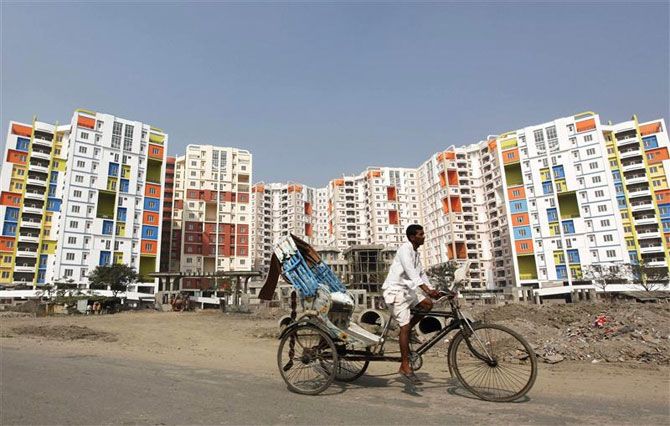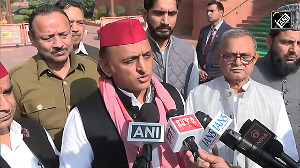 The Centre has revised the definitions for classifying households under the LIG and economically weaker sections categories.
The Centre has revised the definitions for classifying households under the LIG and economically weaker sections categories.
If you come from one of the seven million low-income group households that have annual incomes between Rs 60,000 and Rs 1,20,000, the government has dashed your dream of getting a 60-square-metre house under its Pradhan Mantri Awas Yojana.
The National Democratic Alliance government at the Centre has revised the definitions used for classifying households under the LIG and economically weaker sections categories.
The EWS category will now include all households earning less than Rs 3,00,000 a year, while the LIG category will comprise those earning between Rs 3,00,000 and Rs 6,00,000 annually.
Seven million households earlier part of the LIG category are likely to come under the EWS category.
Each of these households will be entitled to an affordable house with an area of 30 sqm, compared with 60 sqm for LIG households.
The Yojana envisages housing to 20 million households by 2022.
This figure is based on a report of the Technical Group on Urban Housing, which in 2012 pegged the housing shortage in urban India at 18.78 million at the start of the 12th Five-Year Plan.
According to government officials the paper spoke to, adjustments were made to this figure by using Census data to arrive at the 20 million estimate.
The report had argued this shortage was unlikely to rise during 2012-17 if the rate of housing stock continued higher than growth in the number of households during the period.
The group had distributed this shortage of 18.78 million across EWS, LIG and MIG (middle income group) household categories to estimate the shortage in each income cohort.
For this, all households earning less than Rs 60,000 a year were classified as EWS.
Those earning between Rs 60,000 and Rs 1,20,000 fell under LIG, while those with an annual income of above Rs 1,20,000 were classified as MIG and above.
Based on these bands, the group had estimated a shortage of 10.55 million housing units among EWS households and 7.41 million in the LIG category.
The rest 0.82 million was among MIG and higher groups.
But now, given the EWS category will consist of all households with an annual income of less than Rs 3,00,000, all 7.41 million households earlier classified as LIG (income between Rs 60,000 and Rs 1,20,000) are likely to be subsumed in the EWS group.
As the total housing shortage in the earlier MIG and above category (households with income above Rs 1,20,000) was a mere 0.82 million, the revised classification does not in any way add to the number of houses the government has to build.
This change in classification will reduce the requirement of land for providing housing for all.
If the government had continued with the old classification, the total area to house 10.55 million EWS households, at 30 sq m a unit, would have been around 316.5 million sq m. For the 7.41 million LIG households, at 60 sq m, it worked out to around 444.6 sqm.
The total requirement, therefore, was 761.1 sqm. But if all LIG households are subsumed in the EWS category, the total area required, at 30 sqm per house, falls to 538.8 sqm.
To be fair, experts point out, the assumption used by the technical group to classify households on the basis of income are not sacrosanct.
States and Union Territories have also been provided flexibility to redefine the annual income criterion.
Further, as the earlier classification was for 2012, adjustments had to be made to the income bands to account for inflation.
But even after discounting these issues, a sizeable section of the 7.41 million households earlier classified as LIG are now likely to be included in the EWS category.
The past performance of similar schemes shows that the government has its task cut out.
Under the Rajiv Awas Yojana 120,000 houses were approved in 116 cities, but only 1,154 units have actually been built, and 18,281 are currently under construction.
Under the Affordable Housing Programme, 20,472 houses were approved, but only 4,528 have been completed, and 2,240 houses are under construction.
Under the Jawaharlal Nehru National Urban Renewal Mission, 1.44 million houses were approved, but 831,000 of those have been completed, while 361,000 are under progress.
The fiscal implication of this scheme is staggering.
The government officials the paper spoke to said no precise estimates of the scheme had been worked out yet.
But a rough calculation suggests that the subsidy burden on the exchequer on account of extending the scheme to 20 million households, at an average subsidy of Rs 150,000 per household, works out to Rs 3 lakh crore (Rs 3 trillion) over seven years.
This is just the central government's 'commitment'.
The total investment required is likely to be of a much higher magnitude. To put this number in perspective, the central Plan outlay for the Ministry of Housing and Urban Poverty alleviation for 2015-16 was only Rs 15,794 crore.
Even the entire allocation to JnNURM, the previous government's flagship programme for urbanisation over a seven-year period, was a fraction of this figure -- Rs 66,085 crore (Rs 660.85 billion).
The image is used for representational purpose only; Photograph: Rupak Dey Choudhury/Reuters











